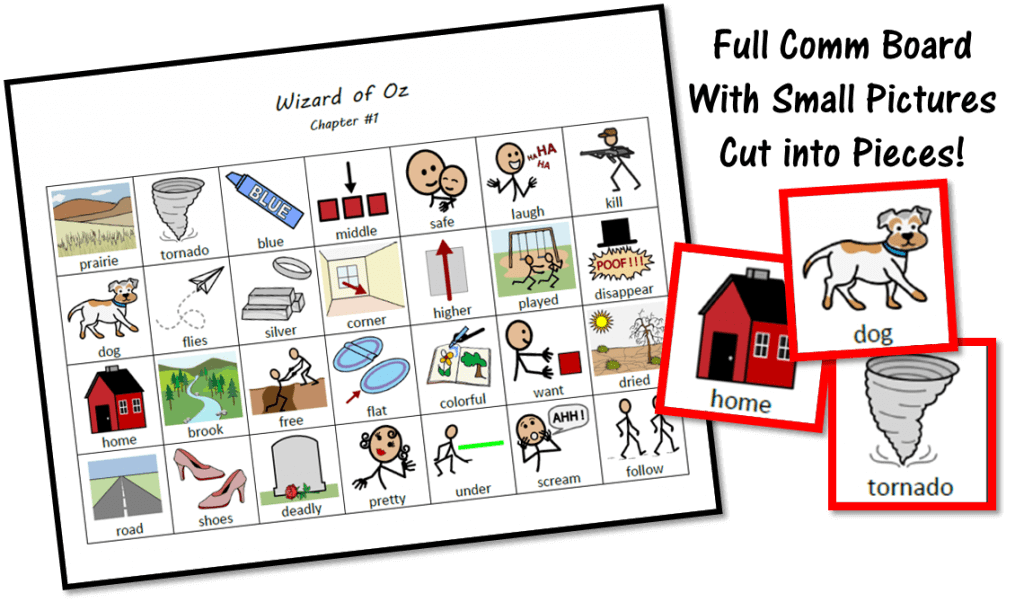I was in a LIFE Skills classroom last week and the teacher told me she never used the Communication Boards that came with the adapted stories. I gasped. What a waste! There are literally more than a dozen activities you can do with a Comm Board. Don’t believe me? Read on!
1. Matching (Identical): Print up two copies of a communication board. Keep one whole and cut the other into small squares. Now have students match the small picture squares with the identical one on the Comm Board.
2. Matching (No Words or No Pictures) Again, print up two copies of the Comm Board, keeping one whole and cut the other into small squares. Then cut those small squares apart, separating the words from picture. Now you can have students match on the large Comm board without the aid of either the word or the picture- whichever you choose.
3. Matching (Word to Picture) This time you only need one copy of the Comm Board. Cut it up into small squares and then separate the word from the picture. Now student must match the word and picture together.
** Please Note: Any of these matching activities can be lessened for students who cannot handle all the words on the Comm Board at the same time. Section out the board by just using a 3 by 3 section or 4 by 4… whatever you need to accommodate for a particular student.
4. Alphabetize Just print one version of the Comm Board and cut it into small squares. Now students can alphabetize the pieces. Need a modification for this? Have an alphabet strip available so there is a good support.
5. Sort (Noun vs Verbs) Print one board and cut into small pieces. With or without a visual support, have students categorize the pieces into nouns and verbs. You can also add adverbs as a category if you’d like!
6. Sort (Singular vs Plural) Just like the prior sort, now students can sort them by singular or plural… and it is up to you as the teacher to use a graphic organizer. You could also use another sorting tool- like placing the pieces into empty baby wipe boxes. Those slots on the top come in handy!
7. Sort (Known vs Unknown) Another sorting task, this one would be more suited to higher functioning students who can actually determine if a word is known or unknown to them. An extension activity could be looking up unknown words or writing sentences with the words that are known. You could also peer partner and a higher reader could “test” the lower reader. Then they could work together to sort words into ones that a student knows versus doesn’t know.
8. Category Sort Students can decide on how to sort pieces- what categories would they choose? You may be surprised! After they sort using a Venn Diagram or T-Chart, ask them what the categories were they decided to use.

9. Hunt for Words With the small squares or the larger board, a student could search for the words within the story. They can write the page number down on the large board, or with the squares, a student can place the square on the page they found it.
10. Sentence Writing Students can write sentences from the words on the Comm Board. For students who are higher leveled, this is a great exercise to see if a student really knows the meaning of the words on the board.
11. Sentence Writing (2 or More Words) One word sentences too easy? Try to present two words at a time that a student has to use in a single sentence. It is harder than is sounds! Now try three… Challenge!
12. Story Writing Using a few words from the Comm Board, have a student make up a whole new story! Let the creative juices flow. Remember, with writing activities, a student does not have to type or write them… they can dictate them into a tape recorder or record them saying the sentences with an iPad or smartphone. Think outside the box!
13. Sentence Building Writing sentences not an option? Try a sentence stem and allow a student to choose a piece from the Comm Board to complete the sentence. Easy ones you can use over and over allow for not having to remake the sentence stems each time the Comm Boards change. Try “I like___”, “I don’t like ___”, “I see ___” or “The ___ is ___”. This can be a great skill builder to move a student to independent sentence writing!
14. Two Word Discrimination (or 3 or 4) With the smaller picture squares, present two words to a student, state the requested square, and then have the student hand you the desired word. You can also use this activity with an eye gaze board for students with limited mobility.
15. Tallying Words With the cut up pieces of the Comm Board, have students select 2, 3, 4, or more pieces and tally how many times they happen in the story! What a great activity to relate the words to the story.
As you know, lots of adapted materials for LIFE Skills come with Communication Boards to use with students. Reworking those boards into student activities in quick and easy ways can help to differentiate and build independence too. Hopefully this list gives you some ideas of activities that will work for you.
Be sure to subscribe to the Noodle Nook Newsletter- you’ll get a free monthly resource in your inbox perfect to use in Autism Units and SpEd classrooms!

So, how many more things can you think of to do with Communication Boards? Share in the comments!
Tweet, Post and Pin! Share this awesome list today!
